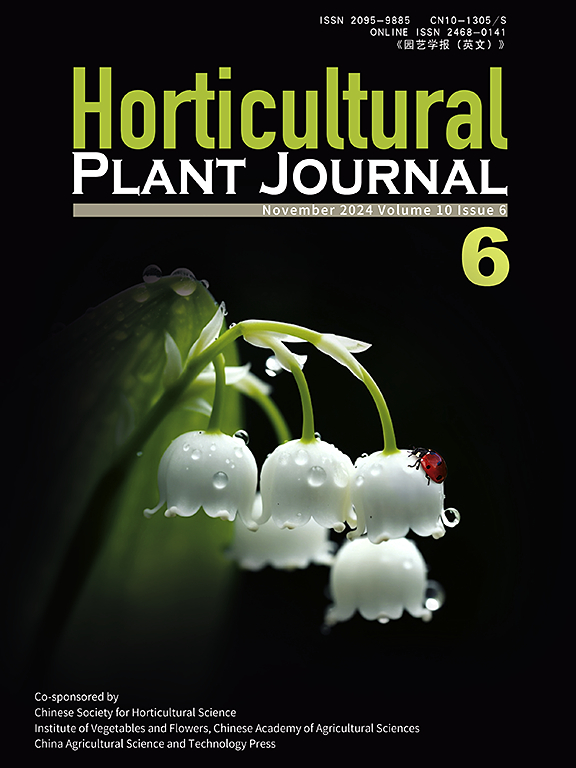抑制CsDREB1B-1通过下调CsNCED1-1的表达和ABA的生物合成来促进柑橘的溃疡病抗性
IF 6.2
1区 农林科学
Q1 HORTICULTURE
引用次数: 0
摘要
柑橘溃疡病,由柑橘黄单胞菌亚种引起。柑橘(Xcc)侵染是全球柑橘产业面临的一个重大问题。胁迫信号是由植物胁迫响应中的几种转录因子(TFs)调控的,包括脱水响应元件结合(DREB) TFs。先前的研究发现,CsDREB1B-1对柑橘中Xcc的侵染有反应;然而,它的功能仍然不明。本研究表明,在Xcc侵染后,CsDREB1B-1在万锦城柑桔(Citrus sinensis Osbeck)易感品种中表达量显著升高。虽然其过表达导致易感性增加,但RNA干扰使CsDREB1B-1沉默并诱导对柑橘溃疡病的更高抗性。此外,利用酵母单杂交(Y1H)实验、双荧光素酶(LUC)报告基因实验和电泳迁移转移实验(EMSA),发现CsDREB1B-1直接控制ABA生物合成必需基因CsNCED1-1的转录。此外,CsDREB1B-1沉默植株的脱落酸(ABA)水平显著降低,水杨酸(SA)水平显著升高,而过表达植株的变化趋势与之相反。结果表明,降低CsDREB1B-1表达减少了CsNCED1-1的ABA积累,从而降低了ABA与sa介导的防御反应之间的抑制相互作用,从而提高了柑橘对溃疡病的抗性。目前的工作提供了遗传资源,以及机制知识,可能有助于生产柑橘溃疡病抗性品种。本文章由计算机程序翻译,如有差异,请以英文原文为准。
Suppression of CsDREB1B-1 promotes canker resistance via down-regulation of CsNCED1-1 expression and ABA biosynthesis in citrus
Citrus canker, resulting from Xanthomonas citri subsp. citri (Xcc ) infection, is a significant problem in the global citrus industry. Stress signaling is regulated by several transcription factors (TFs) in the plant stress response, including dehydration-responsive element-binding (DREB) TFs. Previous studies have found that CsDREB1B-1 responds to Xcc infestation in citrus; however, its function remains unidentified. This study showed that following Xcc infection, CsDREB1B-1 expression was significantly increased in the susceptible Wanjincheng orange (Citrus sinensis Osbeck) cultivar. While its overexpression resulted in increased susceptibility, RNA interference silenced CsDREB1B-1 and induced higher resistance to citrus canker. Furthermore, utilizing the yeast one-hybrid (Y1H) experiment, dual-luciferase (LUC) reporter assay, and electrophoretic mobility shift assay (EMSA), CsDREB1B-1 was found to directly control the transcription of CsNCED1-1, a gene essential for ABA biosynthesis. Moreover, CsDREB1B-1 silenced plants displayed a substantial reduction in the abscisic acid (ABA) and a significant increase in salicylic acid (SA) levels, while the overexpression plants showed an opposite trend of change. The results showed that lowering CsDREB1B-1 expression caused less ABA build-up from CsNCED1-1 downregulation, which then decreased the inhibitory interaction between ABA and SA-mediated defensive responses, which improved resistance to citrus canker. The current work provides genetic resources, as well as mechanistic knowledge, that may help produce citrus canker-resistant varieties.
求助全文
通过发布文献求助,成功后即可免费获取论文全文。
去求助
来源期刊

Horticultural Plant Journal
Environmental Science-Ecology
CiteScore
9.60
自引率
14.00%
发文量
293
审稿时长
33 weeks
期刊介绍:
Horticultural Plant Journal (HPJ) is an OPEN ACCESS international journal. HPJ publishes research related to all horticultural plants, including fruits, vegetables, ornamental plants, tea plants, and medicinal plants, etc. The journal covers all aspects of horticultural crop sciences, including germplasm resources, genetics and breeding, tillage and cultivation, physiology and biochemistry, ecology, genomics, biotechnology, plant protection, postharvest processing, etc. Article types include Original research papers, Reviews, and Short communications.
 求助内容:
求助内容: 应助结果提醒方式:
应助结果提醒方式:


